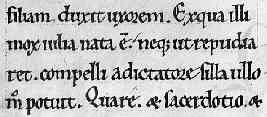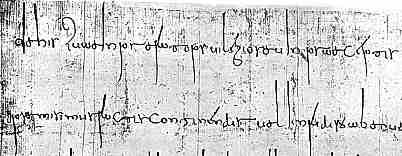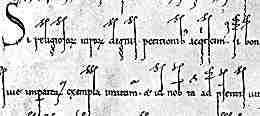 |
| Why Paleography Sucks (2) |
| A particular problem for newcomers to the discipline, and it overlaps and interacts with the issues previously discussed, is the descriptive language of paleography. There is a large vocabulary of strange classificatory terms, and many of them are in Latin. This is not, in itself, surprising. The people who invented the terminology were the very people who studied Latin manuscripts and naturally they were well versed in the language. It seemed all very natural to them. It also follows the model from the sciences of raiding Classical languages for new technical vocabulary. Dare I even suggest that it makes a rather intuitive, descriptive discipline like paleography look more scientific if it employs hierarchical Latin terminology. But scripts are not like species of plants or animals. |
 |
This example is from a 12th century French copy of De Vita Caesarum by Gaius Suetonius Tranquillus (British Library, Egerton 3055, f.2), by permission of the British Library. |
Michelle Brown of the British Library, who has taken great pains to develop elaborate and precise schemes of nomenclature for Gothic scripts, based on and developing the usages of her predecessors, has termed the script of the example above littera minuscula protogothica textualis libraria media/formata . Eek! So what does it mean? Let's just pick it apart: littera : It's a script. It's made of letters. minuscula : It's a minuscule script, made of small letters, not capitals. protogothica : It's somewhere between Caroline minuscule and fully developed Gothic in terms of letter forms, called protogothic in English. textualis : It's the most formal type of Gothic book hand, which is supposed to look rather like a woven textile. libraria : The script is middle range in terms of its formality within the type textualis. The bottoms of the letters are flicked up rather than forming little blocky feet. media/formata : It is, however, quite nicely done, if not the most carefully constructed of its type. So it all means something, but there are problems. One is a certain subjectivity about where the classificatory boundaries should be drawn. In the Latinate terminology of zoology, a horse is a horse (equus caballus) and a zebra is a zebra (equus quagga and others) and there is nothing in between, even though they both belong to the genus equus. In handwriting, styles tend to grade into one another, geographically, chronologically and in terms of the formality of the script. For example, some paleographers do not recognise the category protogothic. The other problem is, unlike zoologists, paleographers have never agreed amongst themselves on a universal classification system, and different systems are in operation. They are not all singing from the same antiphoner. |
| Some paleographers of earlier days, and particularly those who worked on legal documents rather than books, used a simple functional terminology. Their terms described what the script was used for, rather than what it looked like. As scripts changed over time, the same terminology was used for scripts used for the same purpose, so paleographical descriptions might use such descriptors as "a high quality charter hand" or " a less formal document hand as used for writs". In English paleography, the term court hand has been used for a whole range of scripts used in all forms of legal writing, from the grandest of royal charters to the scruffiest of writs and the more hastily written hands used for court reporting, as well as for general business hands. The term court hand has historical credibility, as writers of the court hand were described in those terms, certainly by the 16th century. |
| The term chancery hand was used to designate the script used in the English chancery, even though it changed over the centuries, and at any given time appeared in varying degrees of formality, depending on the use to which it was being put. Furthermore, the style of script used in the chancery was used for legal documents from other sources, and even for books, particularly in the later middle ages. |
 |
 |
 |
 |
| Examples of chancery hands, or court hands, from royal charters of William I, John, Edward III and Henry VI. |
| The term set hands was used for the recognisable and formal styles of script which gradually developed for specific purposes and by particular writing departments. The term free hands referred to the individual styles which writers employed for less formal purposes. All very simple, provided you are only looking at English examples. Interestingly, the writers Charles Johnson and Hilary Jenkinson, way back then produced their handbook because they perceived that paleography had concentrated up to that time on book hands and there was no visual reference material for the historian studying documents in the public records. This ancient tome is still the primary reference for the subject, although Hector's much less extensive but more petite little handbook is more convenient for bringing into the archives for reference. Historians do not study paleography, they just want to read stuff. |
| The earliest document hands in Continental Europe could also be seen as having a functional classification, but because the curialis, as used in the papal chancery, and Merovingian chancery script, as used by the Merovingian and Carolingian chanceries, were highly distinctive scripts, the terms also serve as identifiers of style. |
 |
This very small segment comes from a fragment of a bull or privilege of Pope John VIII, of 876 (Paris, Bibliothèque Nationale, Ms lat 8840). |
| The term diplomatic minuscule, used for formal documents across a wide area of western Europe after the adoption of Carolingian writing reforms finally percolated from book hands to document hands, could also be seen as a functional description. It is the script used for writing diplomas; the term used for formal charters in Continental European terminology. It also has a stylistic component, as the script, which appears in various grades depending on the significance of the document, is based on the letter forms of Caroline minuscule. What distinguishes it from book hand is an array of twiddly ornamentation on the ascenders and descenders of letters, some strange laterally elongated letter forms in odd places and vertically elongated letter forms in headings, outlandish ligatures and very elaborate abbreviation marks. The fundamentals of the script remained quite conservative for centuries, but the basic rule is that the more important a document purports to be, the more distracting detail there is to render it more or less illegible. |
 |
This segment is from a diploma of the emperor Conrad III of 1139. |
| In the later medieval period, as writing became a more widely practised activity, styles from different geographical areas interacted, and book and document hands became hybridised. The terminology becomes more complex and confused, and then falls in a heap. |
|
 previous page previous page |
 Why
Read It? Why
Read It? |
|
 |
 |
 |
 |






